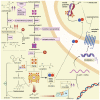Endothelial Dysfunction in Acute Hepatic Porphyrias
- PMID: 35741113
- PMCID: PMC9221615
- DOI: 10.3390/diagnostics12061303
Endothelial Dysfunction in Acute Hepatic Porphyrias
Abstract
Background Acute hepatic porphyrias (AHPs) are a group of rare diseases caused by dysfunctions in the pathway of heme biosynthesis. Although acute neurovisceral attacks are the most dramatic manifestations, patients are at risk of developing long-term complications, several of which are of a vascular nature. The accumulation of non-porphyrin heme precursors is deemed to cause most clinical symptoms. Aim We measured the serum levels of endothelin-1 (ET-1) and nitric oxide (NO) to assess the presence of endothelial dysfunction (ED) in patients with AHPs. Forty-six patients were classified, according to their clinical phenotype, as symptomatic (AP-SP), asymptomatic with biochemical alterations (AP-BA), and asymptomatic without biochemical alterations (AP-AC). Results Even excluding those under hemin treatment, AP-SP patients had the lowest NO and highest ET-1 levels, whereas no significant differences were found between AP-BA and AP-AC patients. AP-SP patients had significantly more often abnormal levels of ED markers. Patients with the highest heme precursor urinary levels had the greatest alterations in ED markers, although no significant correlation was detected. Conclusions ED is more closely related to the clinical phenotype of AHPs than to their classical biochemical alterations. Some still undefined disease modifiers may possibly determine the clinical picture of AHPs through an effect on endothelial functions.
Keywords: acute hepatic porphyrias; chronic kidney disease; endothelial dysfunction; endothelin; heme; hypertension; nitric oxide; porphyria; rare diseases; δ-aminolevulinic acid.
Conflict of interest statement
The authors declare no conflict of interest.
Figures









References
LinkOut - more resources
Full Text Sources

